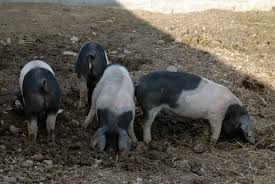Type the name of the breed you're looking for below
[wpdreams_ajaxsearchlite] Don't see the breed your're looking for? Click here and let us know!
Angeln Saddleback pig
| Place of Origin | Germany |
| Origin | Saddleback, also known as the Angler Sattelschwein (Danish: Angler sadelsvin), is a rare breed of domestic pig grown mainly in Schleswig-Holstein, Germany. The breed originated in Angeln, Germany, by crossing a local German black-and-white Landrace with Wessex Saddleback. It became established in Schleswig-Holstein as a separate and distinct breed in 1937, and by the 1950s commanded a substantial local market share. In recent years, however, it has become nearly extinct as market sentiment has turned against its fatty meat. It is well adapted to outdoor systems of management and is likely to see an upturn in popularity as breeders turn away from more intensive systems of production. |
| Purpose | Meat |
| Characteristics | Typical sizes are 350 kg (770 lb) weight, 92 cm (36 in) height (boars), and 300 kg (660 lb)weight, 84 cm (33 in) height (sows). The sows are highly fertile with much milk. It is a large, lop-eared, black pig with a white belt around its body at the forefeet. |



